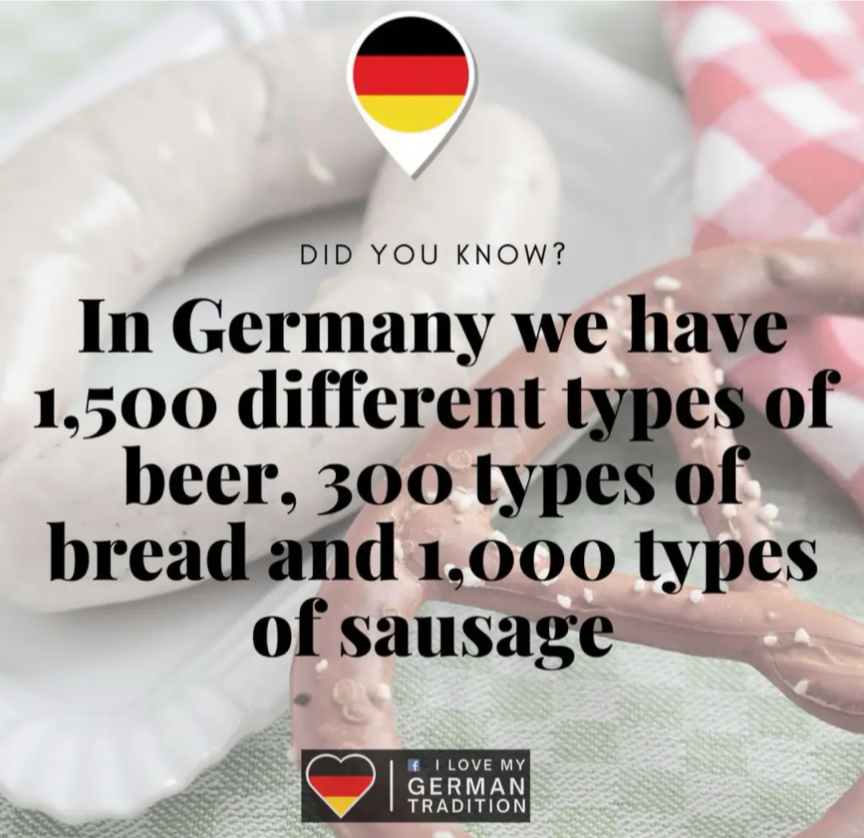Volkswurst Stories
Learn a little more about Germany with Volkswurst!


- October 14 2024
- Volkswurst
Germany’s Most Famous Exports
When you think of German cuisine, a few iconic staples come to mind—Bratwurst, Beer, and Bread. These three items have become synonymous with Germany's culinary tradition and are among the country’s most famous food exports. Whether you're enjoying a Bratwurst at a summer barbecue, sipping a cold German beer at Oktoberfest, or indulging in a fresh-baked Brezel (pretzel), German food has made its mark on menus around the world. But what makes these foods so iconic, and how did they become such important exports? Let’s dive into some fascinating facts about these German culinary classics.
Bratwurst: Germany’s Sausage Superstar
One of Germany’s most well-known exports is the Bratwurst—a delicious sausage that has been enjoyed in the country for centuries. Bratwurst is typically made from pork, but regional varieties can include veal or beef. What makes Bratwurst stand out is the unique blend of spices used in its preparation. Depending on the region, a Bratwurst might be seasoned with marjoram, caraway seeds, garlic, or nutmeg, giving each one a distinct flavor.
The history of Bratwurst dates back to the Middle Ages, with one of the first mentions appearing in a document from Nuremberg in 1313. This city is still renowned for its version of the Nürnberger Rostbratwurst, a small and flavorful sausage that enjoys protected geographical status within the European Union. This means that only sausages produced in Nuremberg can officially carry the name.
Bratwurst is more than just a meal—it’s a cultural icon. Traditionally grilled and served with mustard and a side of bread or sauerkraut, Bratwurst is a favorite at summer festivals, barbecues, and Christmas markets. In fact, it’s so popular that Bratwurst has become a staple of German street food culture. Today, you can find German-style Bratwurst not only in Europe but in countries like the United States, Australia, and Canada, where it has been embraced by meat lovers across the globe.
Beer: A Staple of German Tradition
When it comes to beer, Germany is one of the most respected brewing nations in the world. With a history that stretches back over 1,000 years, beer has become an essential part of German culture and an international symbol of the country’s brewing excellence. The most famous German beers are brewed according to the Reinheitsgebot, or German Beer Purity Law, which was introduced in 1516. This law stipulated that beer could only be brewed using barley, hops, and water (yeast was later added to the list as brewing techniques evolved).
The result of this commitment to purity and quality is a diverse range of beers, from pilsners and lagers to wheat beers and bocks. German beer has become famous for its distinctive, clean taste and rich flavor profiles, making it a sought-after export around the world. Festivals like Oktoberfest in Munich have brought even more international attention to German beer culture, attracting millions of beer enthusiasts who want to experience the tradition firsthand.
Germany exports millions of liters of beer each year, with popular brands like Beck's, Warsteiner, and Paulaner finding their way into supermarkets, pubs, and restaurants across the globe. Whether you're sipping a cold pint at a local pub or enjoying a Stein at Oktoberfest, you're partaking in a tradition that has been perfected over centuries.
Bread and Brezels: A Staple of German Cuisine
Bread is another cornerstone of German cuisine and one of the country’s most significant culinary exports. Germany is often referred to as the "land of bread," and for good reason—there are more than 3,000 different types of bread produced across the country. Whether it's a crusty rye bread, a hearty pumpernickel, or a soft and chewy Brezel (pretzel), bread is an integral part of the German diet.
German bread is known for its variety and quality, with each region offering its own unique styles and recipes. In southern Germany, for example, you'll find the iconic Brezel—a soft pretzel that is often enjoyed with a cold beer or as a snack at a street market. The distinctive shape, golden-brown crust, and slightly salty flavor make Brezels a beloved part of German culinary tradition.
Bread plays a central role in German mealtime. Whether it’s served as part of a Brotzeit (a traditional bread-based meal) or paired with sausages and cheeses, bread is always present at the table. German bread has also gained international recognition, with bakeries around the world offering their own versions of rye and multigrain loaves, inspired by German recipes. The export of German bread products has allowed people across the globe to enjoy a taste of this age-old tradition.
The Global Appeal of German Cuisine
Bratwurst, beer, and bread have all become international ambassadors of German food culture. These staples not only represent Germany’s rich culinary history but also its enduring influence on global cuisine. Whether you're at an Oktoberfest celebration in Canada, a German bakery in New York, or a beer hall in Melbourne, you can experience a slice of German food culture that has traveled far beyond its borders.
As exports, these foods continue to be in high demand, spreading the flavors of Germany across the globe. So next time you bite into a Bratwurst, enjoy a pint of German beer, or savor a fresh-baked Brezel, remember that you’re partaking in a culinary tradition that’s centuries old and loved the world over.
Leave your thought here
Your email address will not be published. Required fields are marked *